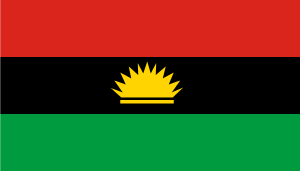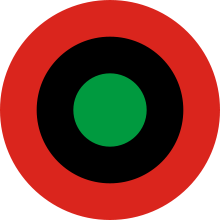Biafran armed forces
| Biafran armed forces | |
|---|---|
 | |
| Active | 1967-1970 |
| Country | Biafra |
| Type | Armed forces |
| Role | Defence |
| Garrison/HQ | none |
| Engagements | Nigerian Civil War |
| Commanders | |
| Air Force Commander | Jan Zumbach |
| Army Commander | Rolf Steiner |
| Navy Commander | William A. Anuku |
The Biafran Armed Forces (BAF) were the military of the secessionist state of Biafra which existed from 1967 until 1970.[1]
History
At the beginning of the Nigerian Civil War, Biafra had 3,000 soldiers. This number grew as the war progressed, ultimately reaching 30,000.[2] No official support for the Biafran Army came from any other nation, although arms were clandestinely acquired. Because of this, the Biafrans manufactured many of their weapons locally.
Some Europeans served the Biafran cause: German born Rolf Steiner was a lieutenant colonel assigned to the 4th Commando Brigade, and Welshman Taffy Williams served as a Major throughout the conflict.[3] A special guerrilla unit, the Biafran Organization of Freedom Fighters, was established: designed to emulate the Viet Cong, they targeted Nigerian supply lines, forcing them to shift resources to internal security efforts.[4]
Army
At the peak of Biafran military power, the Biafran Army was made of 5 divisions; numbered 11th, 12th, 13th (later renumbered 15th), 14th and 101st. It also had 2 separate brigades, the S Brigade, a Pretorian guard for General Ojukwu[5], and the 4th Commando Brigade (trained and commanded by mercenaries)[6].
Air wing

The Biafrans set up a small, yet effective air force. Biafran Air Force commanders were Chude Sokey and later Godwin Ezeilo, who had trained with the Royal Canadian Air Force.[7] Its early inventory included two B-25 Mitchells, two B-26 Invaders, (one piloted by Polish World War II ace Jan Zumbach, known also as John Brown)[8], a converted DC-3 and one Dove. In 1968, Swedish pilot Carl Gustaf von Rosen suggested the MiniCOIN project to General Ojukwu.
By early 1969, Biafra had assembled five MFI-9Bs in Gabon, calling them "Biafra Babies". They were coloured green, were able to carry six 68 mm anti-armour rockets under each wing using simple sights. The six planes were flown by three Swedish pilots and three Biafran pilots. In September 1969, Biafra acquired four ex-Armee de l'Air North American T-6Gs, which were flown to Biafra the following month, with another T-6 lost on the ferry flight. These aircraft flew missions until January 1970 manned by Portuguese ex-military pilots.[7]
During the war, Biafra tried to acquire jets. Two Fouga Magister and several Gloster Meteor were bought but never arrived to Biafra, being abandonned on foreign African airbases.[9]
| Aircraft | Origin | Number | Notes |
|---|---|---|---|
| MFI-9B "Biafra Babies" | Sweden | 2[9] | |
| Douglas B-26 Invader | USA | 2[10] | |
| North American B-25 Mitchell | USA | 2[11] | |
| de Havilland Dove | UK | 1 | |
| Fokker F27 Friendship | Netherlands | 1[11] | |
| Douglas DC-3 | USA | 1[11] | |
| North American T-6 Texan | USA | 6[9] |
Navy
Biafra had a small improvised navy, but it never gained the success of the air force. It was headquartered in Kidney Island, Port Harcourt, and was commanded by Winifred Anuku. The Biafran Navy was made up of captured craft, converted tugs, and armored civilian vessels armed with machine guns, or captured 6-pounder guns. It mainly operated in the Niger Delta and along the Niger River.[10]
| Ship | Origin | commissioned | Fate | notes |
|---|---|---|---|---|
| BNS Vigilance | ex-NNS Ibadan | 30 May 1967 | Sunk on 10 September 1967[12] | Ford-class seaward defence boat |
| NSS Bonny | ex-HMS Gifford | 1968 | Preserved at the National Nigerian War Museum | Ford-class seaward defence boat |
| Ikwerre | ex-Nigerian port authority tugboat[13] | 1967[14] | Armed with a 105mm howitzer[13] | |
| PC101 | ex-Nigerian port authority cutter[15] | 1968 | Lost in July 1968[14] | Armed with 6-pounder and Bofors gun[16] |
| PC202 | Nigerian tugboat[15] | 1968 | Lost in July 1968[14] | Armed with a 105mm howitzer[17] |
| PC203 | Nigerian tugboat[15] | 1968 | Sunk in September 1968[14] | |
| PC204 | Nigerian civilian craft | 1969[14] |
Weapons and equipment used by Army and militias
| Type | Origin | notes |
|---|---|---|
| Dane gun | home-made | In service with militias[18] |
| Lee–Enfield No.4 | ex-Nigerian Army | 120 to 150 in January 1967[19] |
| Vz. 24 rifle | Czechoslovakia (officially denied) | 1,860 bought at the beginning of 1967[20] |
| Vz. 52 rifle | 820 bought at the beginning of 1967[20] | |
| Vz. 58 rifle | 732 bought at the beginning of 1967[20] | |
| MAS 36 | Gabon, Ivory Coast, Haiti | [21] |
| FN FAL/SLR | Parker-Hale (United Kingdom) | 930 delivered in 1967[21] |
| CETME rifle | ? | [22] |
| Type | Origin | notes |
|---|---|---|
| CZ-247 | Czechoslovakia (officially denied) | 300 bought at the beginning of 1967[20] |
| CZ-23 and CZ-25 | ||
| Lanchester Mk I | ? | Some used by mercenaries[22] |
| Type | Origin | notes |
|---|---|---|
| Vz. 26 machine gun | Czechoslovakia (officially denied) | 55 bought at the beginning of 1967[20] |
| Vz. 30 machine gun | ||
| Vz. 52 machine gun | ||
| Vz.59 machine gun | ||
| Vz. 37 heavy machine gun | 20 bought at the beginning of 1967[20] | |
| MG34 | [20] | |
| Bren | ex-Nigerian Army | ~12 in January 1967[19] |
| Type | Origin | notes |
|---|---|---|
| Pancerovka P-27 (RPG-7) | Czech-made | [21] |
| Type 56 RPG | Chinese-made[23] | |
| SARPAC | French-made | Some from 1968[21] |
| Homemade 6-in rocket launcher | Biafran Research and Production | [24] |
| Type | Origin | notes |
|---|---|---|
| 2-in mortar | ex-Nigerian Army | [21] |
| Ordnance ML 3 inch mortar | ||
| L-N 81mm mortar | Spanish-made | At least 6[21] |
| MO-120 AM-50 | French-made | [21] |
| Type | Origin | notes |
|---|---|---|
| Canon de 75 modèle 1897 | Never used in combat (unable to fire)[25] | |
| Oerlikon 20 mm cannon | Hispano-Suiza (Spain) | [25] |
| M18/49 105mm howitzer (upgraded 10.5 cm leFH 18/40) | Czech-made | |
| Ordnance QF 6-pounder | ex-Nigerian Army | |
| Bofors 40 mm gun | ||
| OTO Melara Mod 56 |
| Type | Origin | Number | notes |
|---|---|---|---|
| AML-60 | ex-Nigerian Army | At least 1 | [25] |
| AML-90 | At least 1 | ||
| Ferret armoured car | At least 1 | ||
| Alvis Saladin | At least 2 | ||
| Alvis Saracen | 1 | ||
| Universal Carrier | French trader | A small number | |
| Homemade armored vehicles | Biafra | ? | A lot of designs[25] |
References
- ↑ Jowett 2016.
- ↑ "Operation Biafra Babies". Retrieved 19 August 2008.
- ↑ "The Last Adventurer" by Steiner, Rolf (Boston:, Little, Brown 1978)
- ↑ Jowett 2016, p. 16.
- ↑ Jowett 2016, p. 13.
- ↑ Jowett 2016, p. 15.
- 1 2 Air Enthusiast No. 65 September–October 1996 pp 40–47 article by Vidal, Joao M. Texans in Biafra T-6Gs in use in the Nigerian Civil War
- ↑ Michael Robson. "The Douglas A/B-26 Invader - Biafran Invaders". Vectaris.net. Archived from the original on 9 May 2013. Retrieved 15 February 2013.
- 1 2 3 Jowett 2016, p. 19.
- 1 2 Jowett 2016, p. 17.
- 1 2 3 Jowett 2016, p. 18.
- ↑ Colledge, J. J.; Warlow, Ben (2006) [1969]. Ships of the Royal Navy: The Complete Record of all Fighting Ships of the Royal Navy (Rev. ed.). London: Chatham Publishing. ISBN 978-1-86176-281-8. OCLC 67375475.
- 1 2 Odu 2009, p. 111.
- 1 2 3 4 5 "Biafra Navy, 1967-70". www.marinavasca.eu. Retrieved 2018-05-13.
- 1 2 3 Odu 2009, p. 154.
- ↑ Odu 2009, p. 153.
- ↑ Odu 2009, pp. 158, 166-167.
- ↑ Jowett 2016, p. 14.
- 1 2 Jowett 2016, p. 21.
- 1 2 3 4 5 6 7 Jowett 2016, p. 22.
- 1 2 3 4 5 6 7 Jowett 2016, p. 23.
- 1 2 Jowett 2016, p. 46.
- ↑ Chinese-made weapons may have come from Zambia or Tanzania (Jowett 2016, p. 23)
- ↑ Jowett 2016, p. 33.
- 1 2 3 4 Jowett 2016, p. 24.
Bibliography
- Jowett, Philip (2016). Modern African Wars (5): The Nigerian-Biafran War 1967-70. Oxford: Osprey Publishing Press. ISBN 978-1472816092.
- Odu, P.J. (2009). The Future That Vanished: A Biafra Story. Xlibris (self-published). ISBN 9781441539724.